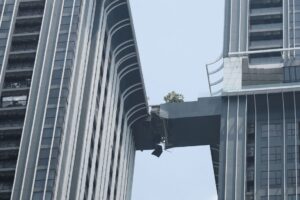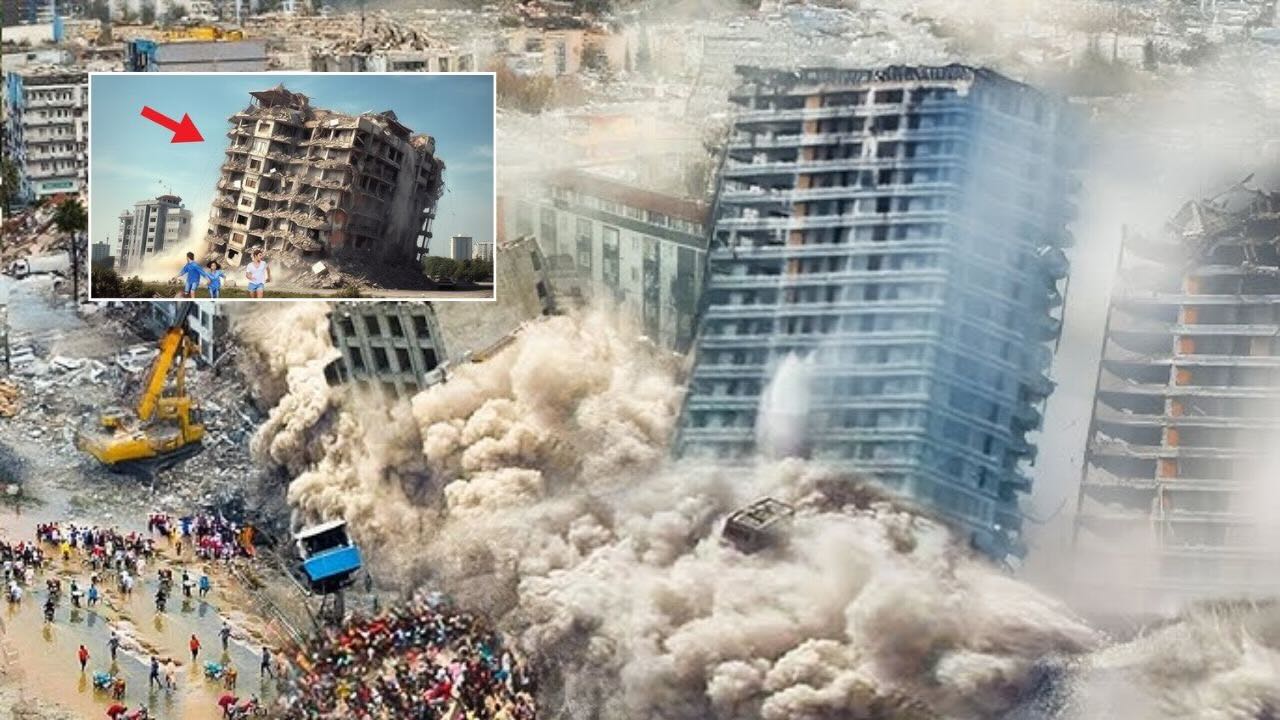- Builders' constructions tailored to buyers' mood
- Construction of skyscrapers with heights of 40, 50, 60 floors
- Will they withstand earthquakes?
The ground trembled beneath our feet. In an instant, massive buildings crumbled before our eyes. The earth shook violently—within minutes, massive property and life losses were left behind. How safe are our skyscrapers? The earthquake that shook two countries has raised numerous fears, questions, and doubts about the safety of skyscrapers, which previously seemed like man-made wonders. What if earthquakes like the ones in Myanmar and Thailand strike Hyderabad? Will the buildings here withstand such forces? How strong are our buildings and skyscrapers? Are builders adhering to NBC (National Building Code) regulations while constructing these towering structures with full quality? Is there a compromise in the selection of construction materials due to the market downturn?
We have seen the devastation caused by the earthquakes in Myanmar and Thailand on social media. Thailand, a country that attracts a huge number of tourists, is home to high-rise buildings and luxury skyscraper hotels, especially in places like Bangkok. These massive buildings, which once appeared grand and magnificent, made everyone rethink after a single earthquake struck. The earthquake caused widespread tremors, and a significant portion of these buildings' structures were severely damaged. Some even collapsed entirely during construction, like sandcastles. There's still no clarity on whether the buildings, whose structures have been compromised, will be usable or not. After inspecting the damaged buildings, if it is determined that they are beyond repair, they will have to be demolished.

We are in second place
In Hyderabad, high-rise buildings are everywhere now. We are second in the country for the construction of skyscrapers. While these are good indicators of development, the real question that needs an answer is what would happen if natural disasters like earthquakes were to occur. Can the buildings in Hyderabad withstand the impact of tremors? Experts say that the city's buildings are safe. They explain that most of the projects in the city are designed to withstand such natural calamities. Structural codes and designs strictly adhere to the city's earthquake profile. This means that buildings in the city are considered to be safe.
Additionally, large developers and builders are following safety standards that go beyond the requirements for seismic zones. Municipal authorities are diligently inspecting these models and ensuring that they comply with the regulations, according to government sources. Generally, multi-story buildings are designed to withstand earthquakes. Builders ensure that the structure will remain stable, even during tremors. However, this is effective only up to a certain point. Experts warn that if severe earthquakes with magnitudes of seven or eight on the Richter scale occur, no structure will be able to stand.
We are not afraid
There is no fear of earthquakes in Telangana. Scientists say that since it is located on the Deccan Plateau at a high elevation from the sea, the people of Hyderabad can live fearlessly. However, this doesn't mean that we can be completely confident about being in a safe zone. Rapid population growth and large-scale projects are raising concerns that earthquakes' effects are inevitable. Furthermore, there are allegations that town planning and fire safety authorities, who are responsible for ensuring security, are involved in corruption and issuing permissions arbitrarily.
While it is claimed that the NBC (National Building Code) regulations are being followed, the visuals of high-rise buildings shaking in Bangkok have made buyers here think twice about their safety.
Central Government to Revise Earthquake Zones
- A new list of earthquake zones will be issued soon.
- Currently, there are five earthquake zones in India.
- The number of zones will increase to six.
- So, which zone does Telangana fall under?
- Is there a possibility of an earthquake in Hyderabad?
- If an earthquake occurs, will multi-story buildings be able to withstand it?
- Are Hyderabad builders and developers following the National Building Code (NBC)?
- Are projects being built as per the National Building Code (NBC) regulations?
- Soon, six earthquake zones in India
Currently, India has five earthquake zones, but their number will soon increase to six. The Geological Survey of India (GSI) established the first five zones in the country in 1962. Later, in 1970 and 1984, the Bureau of Indian Standards (BIS) made some modifications to the extent of the zones and changed the areas under them. In 2002, these zones were further developed under IS 1893:2002. However, as the speed of movement in the Earth's tectonic plates increases, resulting in several changes, geophysicists, experts from the Geological Survey of India, earthquake researchers, and BIS officials have formed a committee to create new zones. They have decided to expand the current five zones into six.
ALSO READ: RBI’s Rate Cut Spurs Hope for Real Estate Revival
According to the earthquake zone classification, if an earthquake has a magnitude of 7 on the Richter scale, it is classified as Zone 5 (the most earthquake-prone area). If the magnitude ranges between 6 and 7, it is classified as Zone 4, and a magnitude of 5 is classified as Zone 3. Areas with earthquake magnitudes ranging between 1 and 4 are classified as Zone 2, which are considered less prone to earthquakes.
In the new standards, except for Bhadradri Kothagudem (Bhadradri district), the entire Telangana state falls under Zone 2, meaning that the risk of earthquakes is low in this region. Hyderabad, therefore, is considered safe from significant earthquake impacts. However, experts caution that this does not guarantee that future earthquakes will not occur.
For instance, in December of the previous year, an earthquake originating in the Mulugu district affected even Hyderabad. This event raised concerns, especially after the impact of the earthquake on high-rise buildings in Bangkok.
In Hyderabad, luxury high-rise buildings, particularly those coming up in areas like Kokapet, are being designed with special features like clubhouses, towers, swimming pools, and walking tracks that connect them. These features are being promoted as unique selling points for apartments, reflecting the growing focus on luxury in the city's real estate.
In Hyderabad, there is growing concern among buyers about the safety of high-rise buildings, especially after recent incidents. These concerns are exacerbated by the behavior of some government departments and officials. It is reported that in various divisions of GHMC (
Greater Hyderabad Municipal Corporation) and HMDA (Hyderabad Metropolitan Development Authority), officials are allegedly involved in corruption and bribery, granting permissions without proper scrutiny.
Town Planning and Fire Safety officers are accused of neglecting their duties, failing to check whether buildings adhere to safety standards and planning guidelines. It has been claimed that some officials are issuing permits carelessly, as long as developers offer bribes or commissions. In recent times, there have been instances in the city where buildings under construction have collapsed, tilted, or cracked, which further highlights the impact of official corruption.
Due to these issues, buyers are being advised to carefully inspect high-rise apartments and flats before making any purchase to avoid potential safety risks.
According to statistics released by the central government based on the 2011 census, a significant percentage of houses in urban and rural areas are constructed using traditional materials such as bricks and stones, as opposed to concrete and steel. Experts argue that in the event of an earthquake, buildings constructed with these materials are more likely to suffer severe damage, resulting in higher risks to both lives and property.
As a solution, experts recommend the use of proper construction techniques, especially in areas prone to earthquakes, to mitigate the risks and ensure safer buildings.
Although Hyderabad is categorised under Zone-Two (which is considered a low seismic risk zone), the rapid growth of high-rise buildings in and around the city raises concerns about their ability to withstand potential seismic events. Experts suggest that these skyscrapers should be constructed according to the standards prescribed for Zone-Three, as the city's development progresses and buildings increase in height.
In relation to housing construction, the Bureau of Indian Standards (BIS) has laid out specific guidelines for building materials, structural integrity, and safety measures. According to the IS-1893 code, all building construction must adhere to certain seismic safety regulations. This code provides detailed instructions on materials and design for ensuring buildings are resilient to earthquakes. By following these guidelines, buildings are more likely to withstand seismic forces with minimal damage and a reduced risk of collapse.

As a result, adhering to these quality standards and using the correct materials and construction techniques significantly lowers the chances of a building being affected during an earthquake.
- The height of the pillars in the building's foundation should be the same as the height of the pillars in the rest of the building.
- The height of the remaining floors should match the height of the basement.
- he shape of the building should follow a uniform and consistent pattern. For example, the base should be smaller and gradually get larger as it rises, or the top should be smaller with a wider foundation at the bottom. Care should be taken to avoid mistakes like a narrow upper section or a widening base.
- The pillars of the building should extend continuously from the foundation to the top floor without any bends in the middle.
- For already constructed buildings, minor structural modifications can be made using retrofitting techniques to make them earthquake-resistant. Triple IT has even developed a special technology for this. However, this is possible for buildings up to 3 stories only.
- As part of retrofitting, repairs are made to the existing buildings to enhance their durability and lifespan.
- In this process, the cement around the outer walls, especially the upper portion of the walls, is removed.
- Instead of cement, mesh is installed, and the surface is then replastered. The same method is applied to doors and windows as well.
- This mesh plastering helps reduce movement in the building's walls during earthquakes, preventing the building from collapsing.
- For retrofitting homes, it is sufficient to spend 30% of the construction cost.
Even though the city is in Zone Two, experts predict that areas like Jubilee Hills and Banjara Hills could be susceptible to small tremors. If an earthquake with a magnitude of 6 on the Richter scale occurs, walls could collapse and buildings may develop cracks within a 15-kilometer radius from the epicenter. The digging of bore wells between 1,500 to 2,000 feet deep is another reason that could increase the chances of earthquakes.
If a major earthquake strikes the city, there are no large open fields nearby to run to for safety. Narrow streets and houses reminiscent of cramped alleyways could lead to significant casualties. Experts are advising that these potential risks be taken into account and caution be exercised in line with the changing circumstances.
They recommend strictly following safety methods in building construction and suggest that houses should be built according to Zone Three standards.
 As a result, adhering to these quality standards and using the correct materials and construction techniques significantly lowers the chances of a building being affected during an earthquake.
As a result, adhering to these quality standards and using the correct materials and construction techniques significantly lowers the chances of a building being affected during an earthquake.

